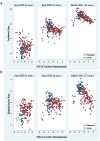Spatial and Ethno-national Health Inequalities: Health and Mortality Gaps between Palestinians and Jews in Israel
- PMID: 39435571
- PMCID: PMC12125490
- DOI: 10.1177/00221465241283455
Spatial and Ethno-national Health Inequalities: Health and Mortality Gaps between Palestinians and Jews in Israel
Abstract
This research adopts an analytical spatial perspective to explain ethno-national health inequality between Palestinians and Jews in Israel. The work identifies the forces that instigated and maintained the spatial segregation of Palestinians and elaborates the role of segregation in generating health gaps between Palestinians and Jews. The analysis suggests a novel conceptualization of two types of segregation: (a) exclusion from the center and confinement to the periphery and (b) segregation within the geographic periphery. Using administrative data on COVID-19 incidence, hospitalization, and death and various health indicators for localities, I devise a decomposition method that evaluates the relative contribution of each type of segregation to the total health gap. The findings indicate that the segregation of Palestinians from the center and their confinement to peripheral regions are crucial determinants of their poor health outcomes and that the segregation of the Palestinian community within the geographic periphery also contributes to poorer health.
Keywords: COVID-19; Palestinians in Israel; ethnic and racial health gaps; spatial inequality; spatial segregation.
Figures



Similar articles
-
Segregation, Choices, and Inequality in Educational Outcomes: Evidence From Revealed Choice Data.Demography. 2025 Jun 1;62(3):1029-1058. doi: 10.1215/00703370-11994413. Demography. 2025. PMID: 40497432
-
Workplace interventions to reduce the risk of SARS-CoV-2 infection outside of healthcare settings.Cochrane Database Syst Rev. 2022 May 6;5(5):CD015112. doi: 10.1002/14651858.CD015112.pub2. Cochrane Database Syst Rev. 2022. Update in: Cochrane Database Syst Rev. 2024 Apr 10;4:CD015112. doi: 10.1002/14651858.CD015112.pub3. PMID: 35514111 Free PMC article. Updated.
-
How to Implement Digital Clinical Consultations in UK Maternity Care: the ARM@DA Realist Review.Health Soc Care Deliv Res. 2025 May;13(22):1-77. doi: 10.3310/WQFV7425. Health Soc Care Deliv Res. 2025. PMID: 40417997 Review.
-
Surveillance for Violent Deaths - National Violent Death Reporting System, 50 States, the District of Columbia, and Puerto Rico, 2022.MMWR Surveill Summ. 2025 Jun 12;74(5):1-42. doi: 10.15585/mmwr.ss7405a1. MMWR Surveill Summ. 2025. PMID: 40493548 Free PMC article.
-
SARS-CoV-2-neutralising monoclonal antibodies for treatment of COVID-19.Cochrane Database Syst Rev. 2021 Sep 2;9(9):CD013825. doi: 10.1002/14651858.CD013825.pub2. Cochrane Database Syst Rev. 2021. PMID: 34473343 Free PMC article.
References
-
- Bank of Israel. 2021. Annual Report 2020. Jerusalem, Israel: Bank of Israel.
-
- Bäuml Yair. 2017. “Israel’s Military Rule over Its Palestinian Citizens (1948–1968): Shaping the Israeli Segregation System.” Pp. 103–36 in Israel and Its Palestinian Citizens: Ethnic Privileges in the Jewish State, edited by Rouhana N. N. Cambridge, UK: Cambridge University Press.
MeSH terms
LinkOut - more resources
Full Text Sources
Medical
Miscellaneous

